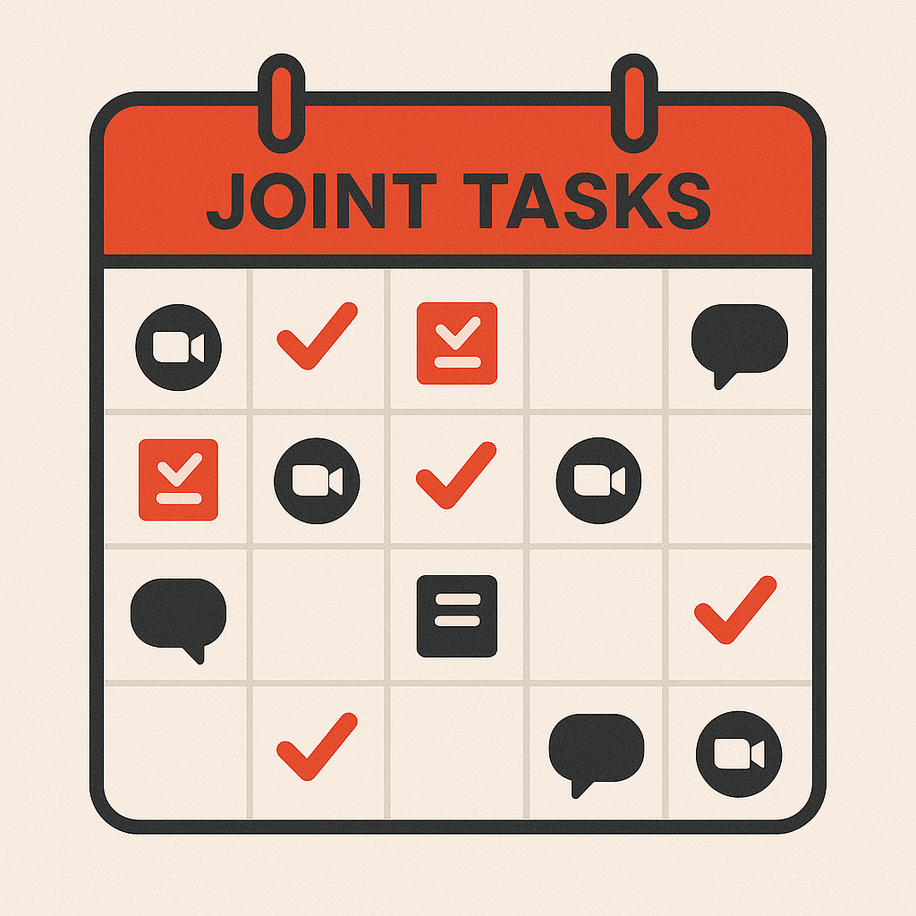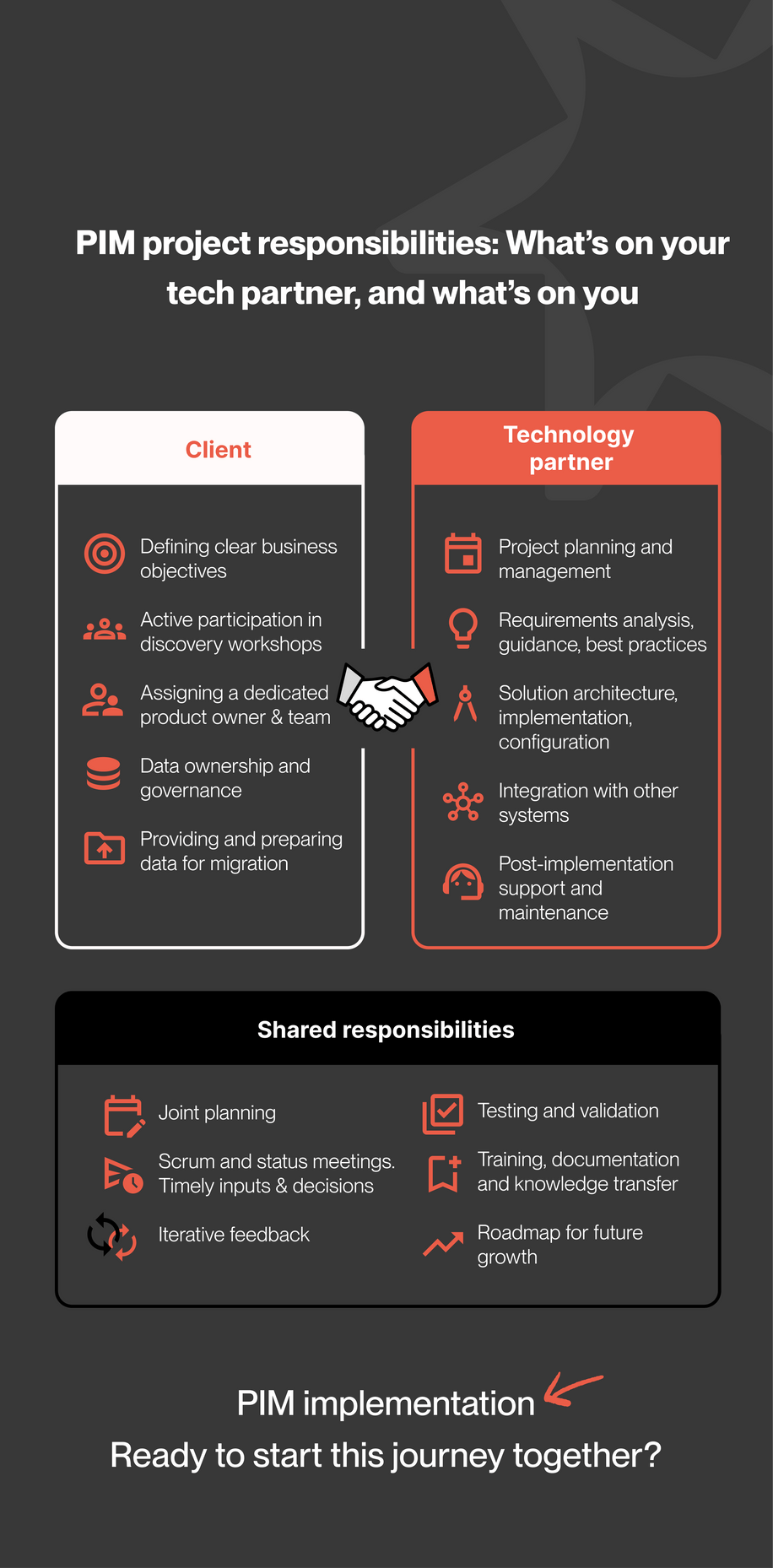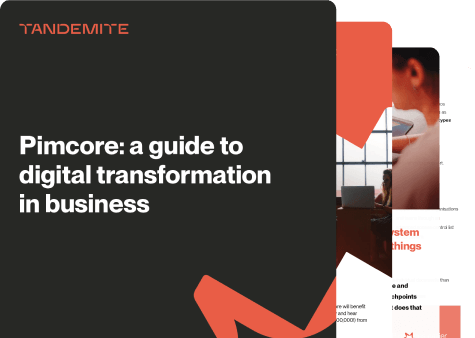PIM project responsibilities: What’s on your tech partner, and what’s on you (spoiler: don't panic!)

When starting a PIM project, many clients ask whether they need to enrich each SKU themselves and set up the category taxonomy, or if our team takes care of it. It’s a fair question. Product Information Management is a new concept for many teams in your organization. This concern highlights a key success factor in PIM implementations: clearly defined RESPONSIBILITIES.
Implementing a PIM system isn’t just a technical task. It’s a strategic project that requires strong cooperation between the PIM solution provider and the client organization.
In this post, we’ll walk you through each side’s role in the process, along with practical examples to illustrate how this partnership works. You will know exactly what’s expected from your team and from your tech partner.
It is essential that you are made aware of this before the start of implementation.
What is a PIM (and why both sides matter)?
Simply put, a PIM (Product Information Management) system is a centralized platform to collect, manage, and enrich all your product information and then distribute it across your sales channels.
It’s the single source of truth for product data – everything from names, descriptions, and specifications to images (except usually real-time data like stock levels). A big advantage of a robust PIM solution lies in its ability to consolidate product data from multiple suppliers, manufacturers, and business partners, regardless of the formats or structures they use. Through automated workflows and configurable rules, PIM platforms enable businesses to normalize and standardize incoming data, ensuring consistency and compliance with internal quality standards and external marketplace requirements.
Now, implementing a PIM is not like installing a simple app. It’s a project that touches many parts of your business: IT, marketing, product management, maybe even your suppliers. That’s why both your internal team and an experienced PIM tech partner need to work closely. The client side brings the business knowledge: you know your products, your data, and your goals. The tech partner brings the platform expertise: they know how to configure the PIM software (whether it’s Akeneo, Pimcore, Ergonode, or another solution) to fit your needs, and how to integrate it into your existing IT landscape. Think of it as a collaborative project where you provide the vision and raw materials, and the partner provides the technical architecture and guidance.
Helpful resources:
How to prepare product data? Checklist for a smooth PIM import
What type of data is stored in a PIM and where does PIM data come from?
Why invest in PIM even if you already use Excel or ERP software?
What common mistakes occur during PIM implementations, and how can they be avoided?
Why define responsibilities up front?
PIM implementations typically involve tight timelines and multiple phases (design, configuration, testing, etc.). When both sides know their duties, they can work in parallel efficiently. For example, while the tech company is configuring the system, your team can be working on gathering and refining product data.
If tasks aren’t clearly assigned, delays can happen. But when you're synchronized, there's no waiting. Each team hands off smoothly to the next, keeping everything moving.
You can explore more about how Pimcore’s workflow management improves operational discipline here.
✅ Client responsibilities in a PIM project
As the client (the company adopting the PIM software), you play a pivotal role in the project’s success. A common misconception is that once you hire a PIM implementation firm, you can step back and let them handle everything. Not quite! Your contributions to certain aspects of the project will have a lasting impact on the final design of the system.
Here are the key responsibilities on the client side:
1. Defining clear business objectives
- What’s involved:
✔️ Clearly articulate what you need from the PIM. What problems are you solving? What goals must it meet?
- Example:
Your company defines the primary goal as reducing product data errors and speeding up the time it takes to launch new products online.
2. Active participation in discovery workshops (preparing requirements for our analysis)
- What’s involved:
✔️ Typically, early in the project you’ll participate in discovery workshops to define your current pain points, use cases, business context, and requirements.
✔️ Name product data sources, share detailed information about your workflows, data structures, and integration needs (like what product attributes, categories, and types you need, what channels you publish to, and how many language versions to include in the system).
✔️ Come prepared to discuss future needs.
✔️ The tech partner can guide this process, but your team knows your business best and must drive the vision of how the PIM will fit into it. Your input is critical for the implementation team to develop a data architecture that truly fits.
- Example:
During a workshop, your marketing team explains the need for multilingual product descriptions, while IT discusses integration with your ERP system.
You sell products like laptops with variants for RAM and storage. You define the business logic: whether to treat these as separate products or variants under a single SKU.
3. Assigning a dedicated product owner & team
- What’s involved:
✔️ Appoint a Product Owner or PIM Project Manager on your team – someone responsible for the project from the client side. This person is the primary liaison with the tech partner and keeps an eye on internal progress. They often lead a core team of your employees (maybe 2-5 people depending on project size) who will actively work on the PIM. This team might include a product data specialist, an IT representative, and someone from marketing or e-commerce.
✔️ The client’s team should be given enough time away from their regular duties to focus on the PIM project. When your dedicated team can allocate sufficient time to collaborate with the partner and provide needed data/files on schedule, the implementation goes faster and smoother.
✔️ Including someone from IT early in the process is essential, especially if you already have an existing ecosystem of platforms. It helps your tech partner design the right connectors and APIs.
✔️ Frequent leadership changes or too many decision-makers disrupt the process.
- Example:
A mid-sized e-commerce company assigned their Head of Business Development as the Product Owner, supported by a cross-functional team from IT and sales.
4. Data ownership and governance
- What’s involved:
✔️ Assign data owners and stewards responsible for maintaining data quality and consistency.
✔️ Define formal rules for approval workflows and version control.
✔️ Assign user roles and access levels based on functional needs, such as marketing or logistics. Internally define who controls what.
- Example:
Your product management team is designated as the owner of technical specifications, while marketing handles content enrichment.
5. Providing and preparing data for migration
- What’s involved:
✔️ Gather all existing product information. This is one of the heaviest client responsibilities. Most PIM projects involve consolidating product data from many sources – ERPs, spreadsheets, CMS, old databases, maybe supplier feeds.
✔️ “Clean” data. Often, product data at the start is messy. You might need to correct errors, fill in gaps (e.g., add missing images or weights), resolve inconsistencies (unify units or naming conventions), and decide what legacy data is worth importing. Identify outdated information and deduplicate (or assign data stewards to handle this).
✔️ Format data for the new PIM, define mandatory fields, and allowed value ranges.
✔️ The implementation partner will advise on best practices and can provide tools or scripts to help with migration, but a significant part of the work lies with your internal team to aggregate and clean the data. Plan enough time and resources for this step – it often takes longer than anticipated, especially if your data is spread out or not well-governed currently.
- Example:
Your team consolidates product information from multiple Excel files, removes duplicate SKUs, and fills in missing attributes like product dimensions.
✅ Tech company responsibilities in a PIM project
On the other side of the coin is the implementation partner (like Tandemite). Our job is to translate your business needs into a working PIM system.
Here are the major responsibilities the tech partner typically handles:
1. Project planning and management
- What’s involved:
✔️ Define the project scope, timeline, deliverables, and key milestones.
✔️ Communicate regularly with the client's Product Owner to sync up plans.
✔️ Keep the implementation train on its tracks and adjust as needed if there are scope changes or blockers.
✔️ Assign a dedicated implementation team to coordinate tasks and ensure timely delivery (you can expect weekly (or biweekly) status calls, progress reports, and issue logs from the partner).
- Example:
The PIM partner sets up a project kickoff meeting, outlines the phases (discovery, pre-implementation analysis, development, testing), and provides a roadmap with deadlines for each stage and milestones (design complete, first prototype, UAT, etc.).
2. Business requirements analysis, expert guidance & best practices
- What’s involved:
✔️ Gather your product information needs.
✔️ Understand your organizational structure, interdepartmental workflows, and how product information moves across the business (not just the data itself).
✔️ Identify gaps between current workflows and align them with PIM capabilities.
✔️ Provide expert input to avoid common implementation pitfalls and follow proven best practice.
- Example:
This can include guidance on data governance (like, “What’s the best way to handle product data versioning across teams?”), performance considerations (e.g., how to structure the system to efficiently support 1M+ SKUs), or simply sharing what has worked for other clients in similar industries. Experience across diverse business scenarios is a big asset.
If your team is uncertain about a process, the tech partner can show how similar companies solved it, often with a live demo or scenario walkthrough.
A good partner will challenge some of your assumptions, too, in a healthy way (“Do you really need 5 levels of categories? Maybe 3 would be more manageable given your current team.”).
3. Solution design and architecture, technical implementation, configuration
- What’s involved:
✔️ Design and optimize the data model (product hierarchies, attributes, families, catalog taxonomy).
✔️ Configure the PIM system to reflect the approved data model and your specific requirements.
✔️ Implement validation rules and automation.
✔️ Implement any workflows for content approval.
✔️ Customize user roles and permissions as needed.
✔️ If your project needs custom features, the tech team will develop those (either by customizing the PIM if it allows, or building add-ons).
- Example:
The provider sets up product categories, defines data validation rules (e.g., mandatory fields like SKU or description), and configures workflows for product approval.
4. Integration with other systems
- What’s involved:
✔️ Use APIs, connectors, or middleware to integrate PIM with other systems such as ERP, eCommerce platforms, DAM, CRM, or marketplaces.
✔️ Ensure seamless data flow between PIM and these systems. Prepare for various scenarios.
✔️ It's not just a technical task – effective integration also requires collaboration with third-party vendors, defining data flows, agreeing on changes, and establishing a shared roadmap. Workshops and alignment meetings are often held before implementation to ensure all parties understand the goals, dependencies, and system behaviors.
- Example:
The provider integrates the PIM software with your Shopify store so that product data updates automatically reflect in your online store.
5. Post-implementation support and maintenance
- What’s involved:
✔️ Offer technical support, system health monitoring, and regular maintenance after the go-live phase.
✔️ Provide updates, bug fixes, and feature enhancements as needed.
✔️ Strategic consultations aimed at aligning PIM capabilities with your growth roadmap, marketing goals, and omnichannel strategy.
- Example:
After go-live, we initiate a 3-month hypercare phase with both technical and business-focused support. Our team not only resolves urgent issues but also collaborates with your stakeholders to identify opportunities for data enrichment, process automation, and improved time-to-market, ensuring the PIM platform drives measurable business value.
✅ Shared responsibilities
We’ve separated client vs. tech partner responsibilities, but there’s also a lot of collaboration and overlap. Let’s talk about how the two sides come together during the project:
1. Joint planning
In the early phase (often called discovery or planning), both teams sit together (virtually or in workshops) to outline the project roadmap. Here, everyone has a voice: your business stakeholders explain needs, the tech partner suggests solutions, and together you prioritize features for launch. It’s a back-and-forth to align the PIM design with business goals. Both sides should agree on a clear project plan.
2. Regular check-ins. Participation in Scrum and status meetings. Timely inputs & decisions
In these calls, the partner’s project manager will update you on progress (“We finished setting up the attribute groups, next we’ll tackle the ERP integration”) and your team will update them on your tasks (“We’ve collected 80% of the product data, aiming to finish by Friday”). These meetings are crucial for surfacing issues early. For example, if your data gathering is falling behind, you can discuss options (maybe the partner can help with automation, or maybe you need to dedicate more people to it).
Prioritize the PIM project internally to keep it moving. Delaying decisions can hold up the whole project.

3. Iterative feedback
Most PIM implementations use an iterative approach. The partner might configure a part of the system and then show it to you for feedback before moving on. For instance, they set up a prototype of your catalog structure with a subset of data. Your team reviews it and says, “This looks good, but we realize we need an additional attribute for packaging dimensions.” That feedback loops back, and the partner adjusts the design. By collaborating in iterations, you ensure the final system truly meets your needs and you avoid expensive rework at the end.
4. Testing and validation
As the system gets configured with your data and business rules, the client tests that everything works as expected from a business perspective (user acceptance testing). That means trying out typical tasks in the new PIM solution: create a product, edit attributes, run an export to your website, etc., to ensure it meets your needs. Your business users should validate that product information is displaying correctly and that workflows/business rules reflect your processes. If something is off, this is when you catch it and inform the partner to adjust.
The tech company is responsible for thoroughly testing PIM systems from a technical standpoint (technical QA). Before we ever hand it to you for UAT, our team should have tested all configurations and customizations: Does the data import correctly? Are the business rules working? Do the integrations send/receive data as expected? Performance testing might be done if you have a huge catalog (to ensure the PIM can handle the load). We’ll fix any bugs discovered during this quality assurance phase.
5. Driving user adoption – Training, documentation and knowledge transfer
Once the PIM is configured and tested, the partner usually conducts training sessions for the client’s users. This is a big part of ensuring the project’s success – if your team doesn’t know how to use the new tool, you won’t get the benefits. Implementation specialists often include training in the project plan.
For example, we might do a series of workshops: one for business users (how to create/update products, manage assets, etc.), one for administrators (how to manage users, permissions, settings), and maybe a technical briefing for your IT (covering how integrations work or how to maintain the system). Moreover, we provide documentation, such as a user manual or admin guide, specific to your configured PIM.
Your team is also responsible for communicating these changes within the organization. Don’t overlook the human side of a PIM project. Internally, you may need to adjust processes now that a PIM is in place. For example, if previously marketing managed product descriptions in spreadsheets and now they’ll do it in PIM, you need to prepare them for that shift. Organize internal workshops to showcase the benefits of the PIM system, explaining how it will simplify product data management and reduce errors.
Discover the role of change management.
6. Roadmap for future growth
Planning ahead means setting goals for future updates, new features, and system changes.
The client should maintain a relationship with the partner for major changes and inform them of any new requirements or issues. If an SLA is signed, partners will also proactively monitor the system and suggest optimizations.
For instance, if a year later you need to integrate a new channel, you might call on the partner for help. This continuous support ensures your PIM environment stays healthy and adapts with your business.
Key takeaways from the blog article
PIM is a team effort: A successful PIM project relies on both the client’s team and the tech partner working together.
Client responsibilities: As the client, you’re expected to assign a dedicated project owner and team, and stay engaged throughout the process. Your role centers on providing guidance (requirements and business context), data (product info and its organization), and feedback. You also drive the organizational adoption – making sure your people are ready to use the new PIM.
Tech partner responsibilities: The tech company’s responsibilities cover all the technical and advisory aspects: from system setup, configuration, and integration to providing expertise, managing the technical project tasks, and supporting you through launch and beyond.
Collaboration is key: Regular communication, status checks, and feedback loops between you and the tech partner keep the project on track. Many challenges (like data inconsistencies or stakeholder buy-in) can be overcome by closely collaborating with your PIM implementation partner.
No matter the industry, the formula is the same: success comes from the client’s subject matter experts and the tech partner’s implementation experts working together. If either side tried to do it alone (client solo or partner solo), it either wouldn’t meet business needs or wouldn’t be technically sound.
By collaborating with an experienced PIM implementation partner, you gain access to specialists who have “seen it all” and can effectively deploy the system while avoiding common pitfalls. Many companies choose to work with a partner rather than try to implement PIM on their own, specifically because of this broad skill set and guidance that the partner provides.

At Tandemite, we chose our name for a reason. We believe in riding together with our clients throughout every project. Whether you’re an e-commerce retailer looking to enrich thousands of SKUs or a manufacturer aiming to streamline complex specs, our team is ready to help, ensuring a successful PIM implementation that keeps you in control and ahead of the competition.
So, shall we hop on the tandem bike and start this journey together? You’ll be supported by experienced professionals who have successfully contributed to many business transformations.
FAQs
Q: The big question is: How do we even start with a PIM project?
A: Start by defining clear business goals: What problems are you trying to solve: data inconsistency, slow time-to-market, inefficient product onboarding? Once you’ve identified the key pain points, conduct a high-level audit of your current product data, systems, and stakeholders. From there, engage a PIM expert or partner early to help design the roadmap, choose the right technology, and outline a phased approach. Starting with a pilot or MVP can reduce risk and validate the business value quickly.
Q: Who takes care of data preparation – us or the PIM partner?
A: The client is responsible for data cleaning and standardization in a PIM project, but with support from the PIM solution provider. This is because the client owns the data, understands its context, and knows how it supports business operations.
Q: Can we implement a PIM without an external tech partner?
A: It’s possible, but generally not recommended unless you have a very skilled in-house technical team with PIM experience. Implementing a PIM involves a lot of specific know-how – from configuring the system optimally to integrating it with other software. If you do go it alone, be prepared to dedicate significant internal IT resources and expect a learning curve. For most mid-sized and large businesses, collaborating with a qualified implementation partner is the safer path to a successful deployment.
Q: How much of my team’s time will a PIM project need?
A: It varies by project scope, but expect to have a core team (perhaps 3-5 people from your side) spending a substantial part of their time on the project for several months. The Product Owner or project lead on your side will be heavily involved throughout, coordinating tasks daily or weekly. Other subject matter experts (like a marketing manager or an IT analyst) might contribute in specific phases (e.g., input during requirements, testing). It’s important to allocate this time explicitly. Don’t underestimate the involvement – your team’s timely collaboration is essential to keep the project on schedule.
Q: What happens after the PIM is live – how are ongoing tasks split?
A: After go-live, the day-to-day operation of the PIM becomes mostly a client responsibility. That includes entering new products, maintaining data quality, and managing users in the system. Your business teams will use the PIM as part of their routine workflows (e.g., the product team adds new items each season, marketing enriches content, etc.). The tech partner usually transitions to a support role. If you have a support contract, the partner will handle things like bug fixes, system updates, performance monitoring, and any new enhancements you request.
It’s wise to have periodic check-ins even post-implementation, to review if the PIM is meeting KPIs and decide if any optimizations are needed. But broadly, once the system is stable, the client owns the process and content within the PIM, and the partner assists behind the scenes with technical upkeep or improvements.





